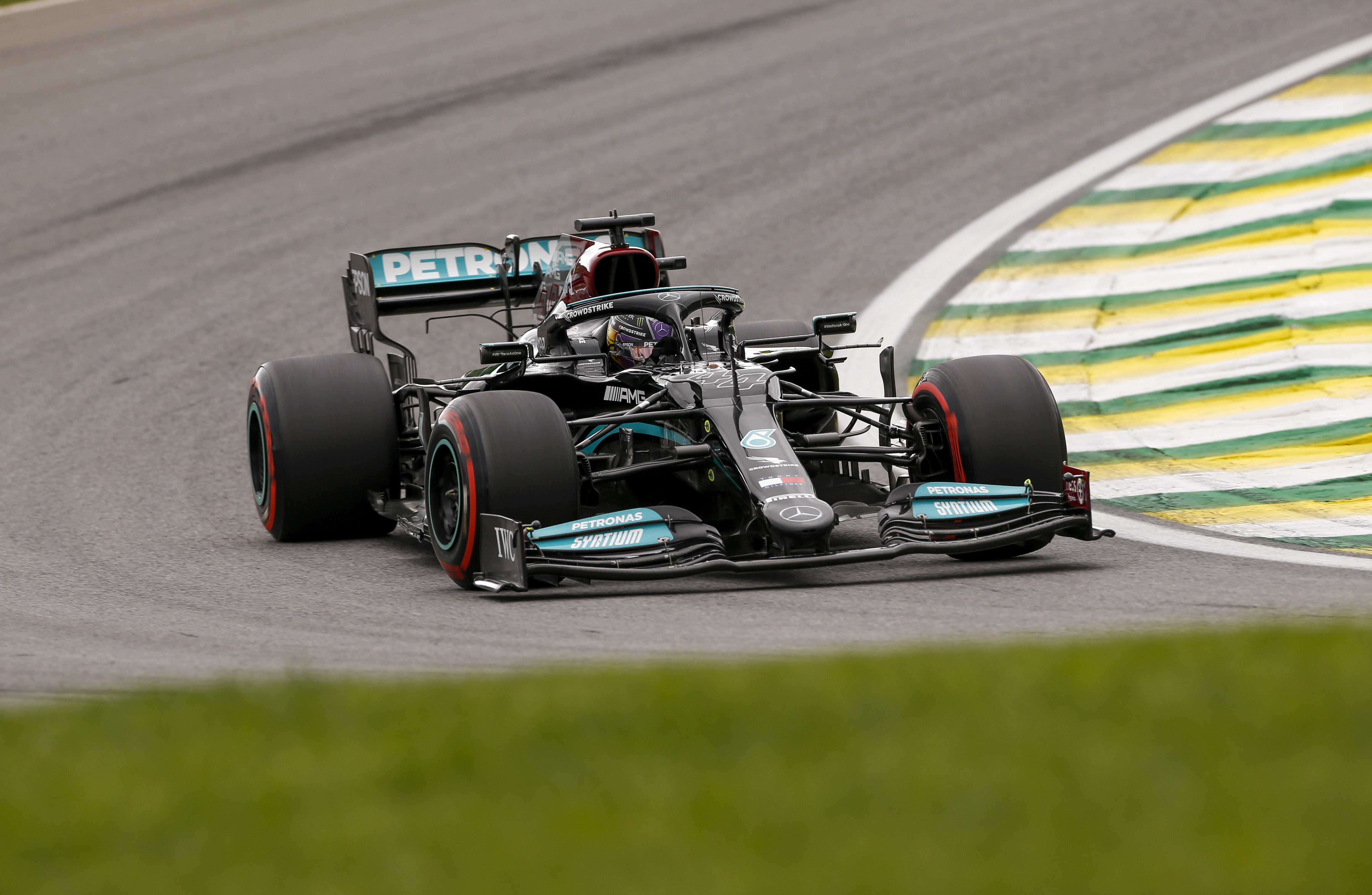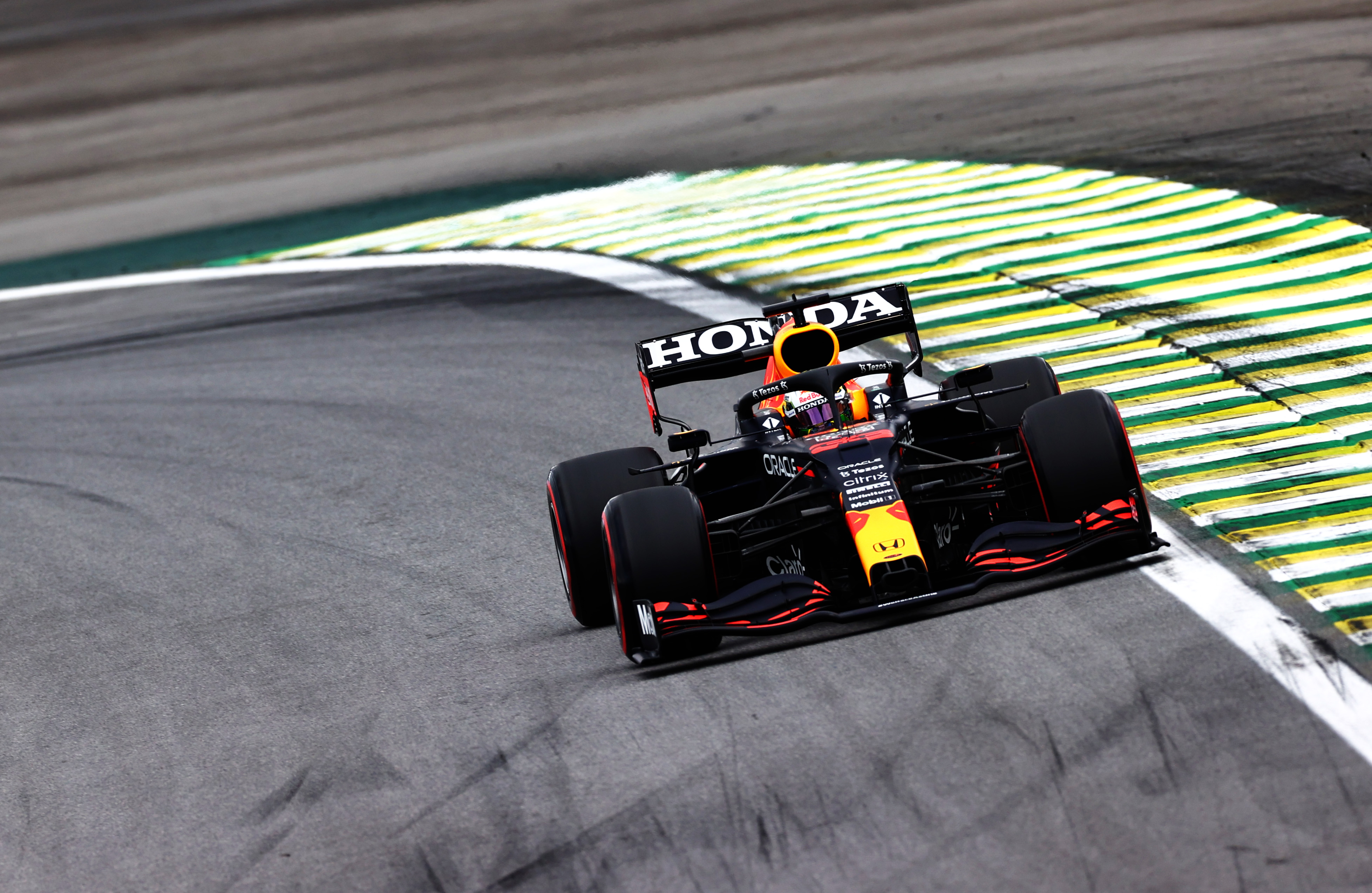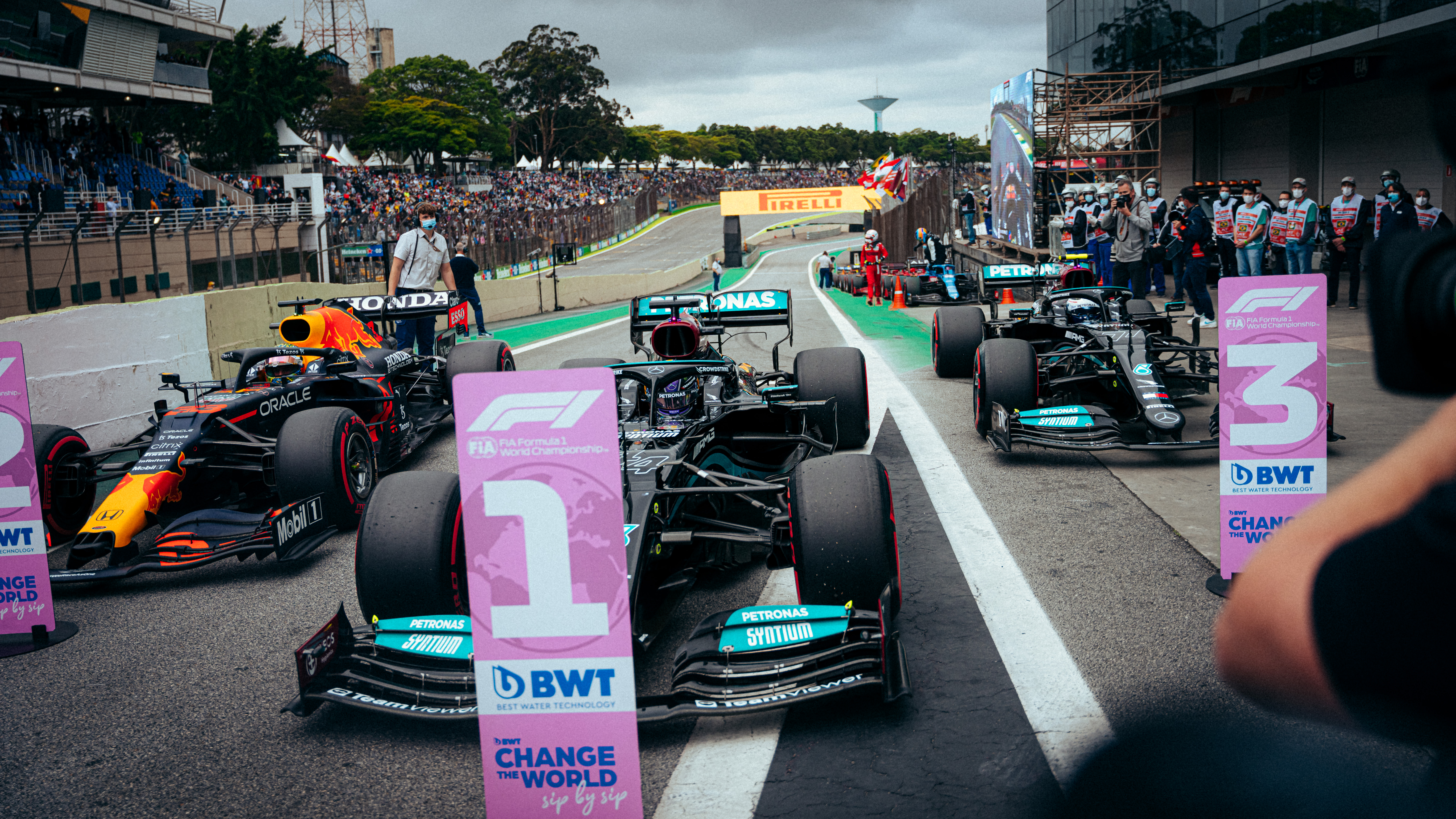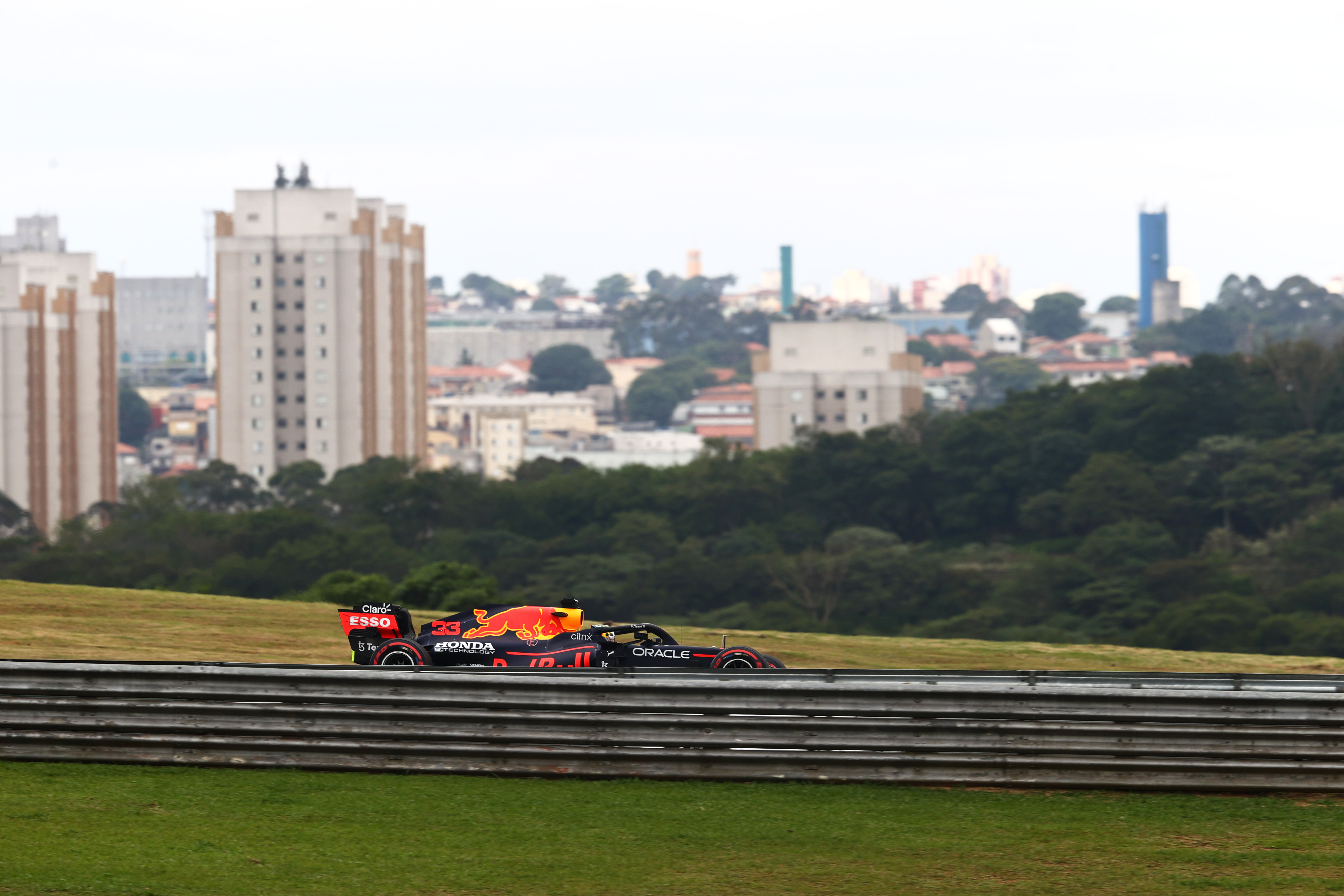Up Next

Lewis Hamilton’s resounding fastest time in Brazilian Grand Prix qualifying – 0.438s clear of second-quickest Max Verstappen around a very short lap – is one of the most dominant qualifying performances of anyone in the 2021 Formula 1 season, although it may yet not count.
It was very much against general expectations, which were that the Mercedes would be, at best, a match for the Red Bull at Interlagos, having been decisively slower in Mexico.
The super-high altitudes of Mexico City (almost four times that of Interlagos) made the Red Bull’s downforce advantage very valuable there.
In Brazil, the downforce advantage is less valuable, especially as the first and third sectors offer the lower-drag Mercedes a good chance to stretch its legs. So that was the basic framework coming into the weekend.
Two crucial things altered that picture on Friday afternoon. 1) Hamilton took a new internal combustion engine and the five-place Sunday grid drop it entails, but crucially the extra horsepower it brings. 2) The Red Bull fell back into the pack compared to its usual performance, so exaggerating the gap to Hamilton, for reasons which may well become crystal clear on Sunday.
In addition, the rear wing discrepancy Hamilton’s car is being investigated over could’ve played a yet-undetermined part.
Mercedes average qualifying gap over best non-Red Bull in season to date: 0.693%
Mercedes qualifying gap over best non-Red Bull Interlagos: 1.241%
Red Bull average qualifying gap over best non-Mercedes in season to date: 0.639%
Red Bull qualifying gap over best non-Mercedes Interlagos 0.596%
It’s crystal clear from those numbers that Mercedes is way faster than its seasonal average relative to the rest of the pack – and that Red Bull was slightly slower than average.
Hamilton’s new power unit

“[Mercedes] seem to degrade more than the Honda engines with mileage,” observed Christian Horner. “One of the outstanding things about the Honda is that there is only about 0.1s difference between fresh and end of mileage.”
No one at Mercedes was revealing how much lap time the fresh PU was worth, but data analysis by Red Bull is suggesting around 0.2s.
Hamilton was a full 0.535s faster than team-mate Valtteri Bottas, but the latter was lamenting a poor Q3 performance with errors on both of his laps. Even with those, he was less than 0.1s away from pipping Verstappen to second.
Past the start/finish line Hamilton was travelling 3.5km/h faster than Bottas, part of which is down to Hamilton getting a better exit from Juncao (Turn 12) at the bottom of the hill. But not all.
With the same wing settings, it’s clear that Hamilton’s power unit is pulling harder than Bottas’, because between the start/finish line and the speed trap at the end of the straight Hamilton’s car accelerates by another 3.7km/h compared to just 1.7km/h for Bottas (with neither being towed).
Given that Hamilton was already travelling faster and that the drag is squaring with speed, to find 2km/h more than the other car between those two points suggests a healthy power advantage.
Of course, it may be more than merely the performance advantage of the fresh engine itself. It may also be that, with an extra power unit in the pool, Mercedes has chosen a more aggressive mode for the weekend than it otherwise would have done.
And there is also, of course, the rear wing issue that is awaiting further evidence and, depending on the exact scope of the alleged breach, could’ve contributed to a gain on the straights for the seven-time champion.
Red Bull’s underperformance

For reference, Verstappen was slowest of all across the start/finish line at 316km/h (196mph), 7.7km/h down on Hamilton. The Red Bull finds 2.1km/h between there and the speed trap. But that’s fairly typical for a Red Bull, the natural penalty for its greater downforce – which would normally be expected to pay back in the repeated twists of sector 2.
The time spent in the low drag-rewarding sectors 1 and 3 is about the same as that spent in the downforce-rewarding middle sector and so in theory the two cars, with their contrasting strengths and weaknesses, might have been expected to be quite evenly matched.
But Verstappen was 0.2 slower than Hamilton through that middle sector. “The front tyres are overheating into [Turn] 8,” complained Verstappen over the radio. “They had died completely by the time I went through Turn 8.” It was the same on both his Q3 runs.
Looking at each of Verstappen’s laps, he is slower through sector 1 on his final run, as was Hamilton – a reflection perhaps of the cooling track temperature. But crucially, Verstappen loses more time than Hamilton. On his first run, he loses 0.145s to Hamilton in this power/drag sector.
But second time through he loses 0.238s. The damage to the lap relative to Hamilton was already done and though he was quicker than before in the next sectors, he still trailed Hamilton – by 0.201s in sector two, which should have been the Red Bull’s best sector, but for it overheating its front tyres.

Comparing the laps of Hamilton and Verstappen, the Red Bull’s understeer can be seen to be building as early as Turn 4. Verstappen needs more steering lock than Hamilton through the uphill kink of Turn 6 too, which is probably what finally overheats those fronts to the point that they are ‘dead’ by the right-hander of Turn 8 where he is scrabbling way further out on the exit than Hamilton and is thus compromised in the line he can take into the left-hander of Turn 9. The lap time is just bleeding away.
“I think as the track cooled through the session, it became worse for us,” said Sergio Perez. “I don’t think we read the conditions very well.”
It seemed a track temperature of just 25-degrees and cooling was enough to expose a trait in the Red Bull seen throughout the season. Its front axle cannot be aerodynamically loaded up as heavily as that of the Mercedes, so its fronts slide more and in certain conditions, particularly in low track temperatures, this overheats the tyre surface.
Where the Red Bull scores over the Mercedes is in rear grip, which becomes more important in higher track temperatures. The Red Bull can usually keep its rear tyres cool better than the Mercedes, but that wasn’t a requirement around a chilly Interlagos. It may however be a very important requirement on Sunday.

“It’s going to get hotter through the weekend,” says Horner, “and the tyres are going to be a factor.” He’s referring to the rears. “I think we will have a very good race car for Sunday.”
Rather implying that it was set up in the full knowledge that in the cooler conditions of Friday it might be difficult, given its propensity not to be able to load the front up aggressively – but with the eye on the bigger prize of Sunday.








